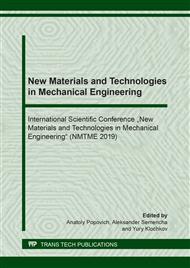[1]
Ivanov V.S. Radiation Chemistry of Polymers. L.: Chemistry, 1988. P. 320.
Google Scholar
[2]
Perova M.S., Galimzyanova R.Y., Khakimullin Y.N., Vol'fson S.I. Influence of the molecular weight of oligoisobutylenes on the properties of uncured sealants // International Polymer Science and Technology. 2011. № 38(12). P. 7-9.
DOI: 10.1177/0307174x1103801203
Google Scholar
[3]
Cherezova E.N., Il'Icheva E.S., Aver'Yanova Yu.A. Influence of the structure of organic peroxides on the efficiency of modification of SKI-3 rubber with dicarboxylic acid anhydrides in solution // Russian Journal of Applied Chemistry. 2011. № 84(11). P. 2018-2020.
DOI: 10.1134/s1070427211110358
Google Scholar
[4]
Il'icheva E.S., Khusainov A.D., Cherezova E.N., Gotlib E.M. High-molecular-weight modifiers with graft anhydride and imide groups: Effect on the adhesion, rheological, and physicomechanical properties of rubber compounds // International Polymer Science and Technology. 2015. № 42(6). P. 17-20.
DOI: 10.1177/0307174x1504200604
Google Scholar
[5]
Nechitailo N.A., Sanin P.I., Polak L.S. et al. The Effect of Gamma Radiation on Polypropylene in the Presence of Stabilizers // Radiation Chemistry of Polymers. M.: Nauka, 1966. P. 272-278.
Google Scholar
[6]
Radiation Chemistry of Polymers. M.: Science, 1973. P. 455.
Google Scholar
[7]
Veselovsky P.A., Leshchenko S.S., Karpov V.L. On Some Features of the Radiation Chemistry of Polypropylene in the Field of Low Doses // Radiation Chemistry of Polymers. M.: Science. 1966. P.268-271.
Google Scholar
[8]
Oliani W.L., Parra D.F., Riella H.G. et al. Polypropylene Nanogel: Myth or Reality, // Radiation Physics and Chemistry. 2012. № 81. P.1460-1464.
DOI: 10.1016/j.radphyschem.2011.12.011
Google Scholar
[9]
Lugao A.B., Cardoso E.C.L., Hutzler B. et al. Temperature-dependent Oxidation Induction Time (TOIT) of Irradiated and Non-irradiated Polypropylene - a New Method // Radiation Physics and Chemistry. 2002. № 63. P. 489-492.
DOI: 10.1016/s0969-806x(01)00544-8
Google Scholar
[10]
Rakhmatullina E.R., Lisanevich M.S., Galimzyanova R.Yu., Khakimullin Yu.N., Mukmeneva N.A. Effect of processing conditions on polypropylene properties // Deformation and destruction of materials. 2017. № 12. P. 35-39.
Google Scholar
[11]
Loginova I.I., Artamonov D.A., Stolyarov O.N., Melnikov B.E. Influence of the structure on the viscoelastic properties of geosynthetic materials // Magazine of Civil Engineering. № 4, 2015. P.11-18.
Google Scholar
[12]
Romanova A.A., Rymkevich P.P., Gorshkov A.S., Stalevich A.M., Ginzburg B.M. A new phenomenon - amplitude-modulated free oscillations in semicrystalline polymers // Journal of Macromolecular Science. Part B: Physics. 2007. Vol. 46 B. № 3. P. 467-474.
DOI: 10.1080/00222340701257703
Google Scholar
[13]
Gorshkov A.S., Makarov A.G., Romanova A.A., Rymkevich P.P. Modeling the deformation processes of oriented polymers based on the description of the kinetics of supramolecular structures separated by energy barriers // Magazine of Civil Engineering. 2013. № 9. P.75-83.
DOI: 10.5862/mce.44.10
Google Scholar
[14]
Rymkevich P.P., Romanova A.A., Gorshkov A.S., Makarov A.G. Physical Foundations of Viscoelastic Behavior of Oriented Amorphous-Crystalline Polymers // Proceedings of Higher Educational Institutions. Light industry technology. 2012. Vol. 16. № 2. P. 70-73.
Google Scholar
[15]
Makarov A.G., Gorshkov A.S., Rymkevich P.P., Pereborova N.V. Method of correction of the parameters of a mathematical model of relaxation of polymers by points of an experimental stretching diagram. Design. Materials Technology. 2012. № 1 (21). P. 23-28.
Google Scholar
[16]
Makarov A.G., Pereborova N.V., Vagner V.I., Rymkevich P.P., Gorshkov A.S. Basics of mathematical modeling of relaxation and creep of polymeric materials of textile and light industry // News of higher educational institutions. Light industry technology. 2013. Vol. 21. № 3. P. 27-31.
Google Scholar
[17]
Makarov A.G., Pereborova N.V., Vagner V.I., Rymkevich P.P., Gorshkov A.S. Basics of confidence prediction of relaxation and deformation processes of polymeric materials of textile and light industry // News of higher educational institutions. Light industry technology. 2013. Vol. 22. № 4. P. 32-34.
DOI: 10.47367/0021-3497_2021_6_226
Google Scholar
[18]
Makarov AG, Pereborova N.V., Vagner V.I., Rymkevich P.P., Gorshkov A.S. Basics of spectral-time analysis of relaxation and deformation properties of polymeric materials of textile and light industry // News of higher educational institutions. Light industry technology. 2014. Vol. 23. № 1. P. 19-23.
DOI: 10.47367/0021-3497_2021_4_186
Google Scholar
[19]
Makarov A.G., Pereborova N.V., Wagner V.I., Rymkevich P.P., Gorshkov A.S. The basis of the spectrum of polymeric materials and textile industry. Light industry technology. 2014. Vol. 23. № 1. P. 24-29.
Google Scholar


